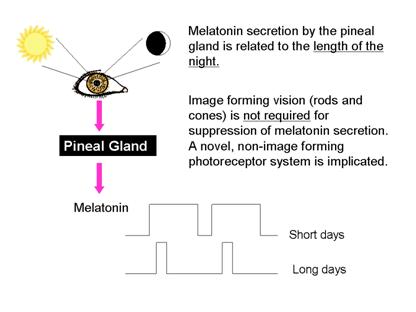The primary physiological function of MELATONIN, whose secretion adjusts to night length (daily duration of high-level secretion is shorter during the summer, when the nights are short, and longer during the winter, when the nights are long), is to convey information concerning the daily cycle of light and darkness to body physiology

Light reaches your master biological clock (SCN) via your eye's optic nerve, where it initiates events such as waking you up, and processes associated with being awake.
MELATONIN is produced/secreted under control of the master biological clock (in response to darkness), such that MELATONIN levels have a 24-hr cycle of marked circadian rhythmicity, which regulates core body temperatures, adrenal CORTISOL (stress hormone) and more
- Low circulating levels of MELATONIN in the daytime
- Rising to maximal levels of MELATONIN during the night
MELATONIN feeds back to the "Biological clock"to regulate its activity -most of the brain receptors for MELATONIN are located in the SCN (in mammals)
MELATONIN appears to have an inhibitory affect on the reproductive rhythm
- In humans, MELATONIN secretion is inversely correlated with gonadal development - peak MELATONIN levels fall just prior to the onset of puberty; also, higher levels of plasma MELATONIN have been noted in women with amenorrhea (no menstruation).
- In mammals other than humans, MELATONIN possibly acts as a breeding and mating cue - since it is produced in greater amounts in response to the longer nights of winter and less so during summer. Dr. George Brainard found that the gonads of male hamsters increased and decreased in size depending on the breeding season or season. He could change their gonad size and MELATONIN production by altering their exposure to light/dark cycles. Animals who time their mating or breeding to coincide with favorable seasons (such as spring) may depend on MELATONIN production and the biological clock to regulate their reproductive cycles on the basis of the length of the solar day.